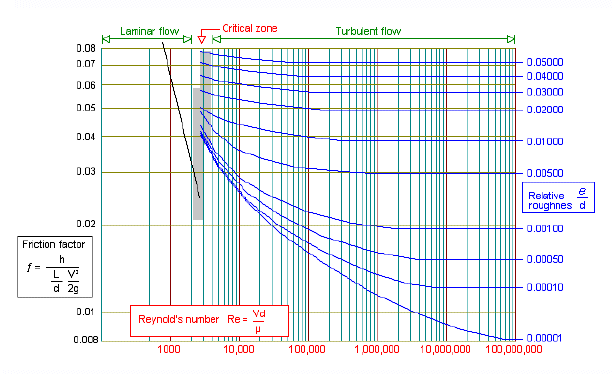Reynolds Numbers
 Fluid flow in a pipe encounters frictional resistance due to the internal roughness (e) of the pipe wall, which can create local eddy currents within the fluid. Calculation of the Reynolds Number helps to determine if the flow in the pipe is Laminar Flow or Turbulent Flow.
Fluid flow in a pipe encounters frictional resistance due to the internal roughness (e) of the pipe wall, which can create local eddy currents within the fluid. Calculation of the Reynolds Number helps to determine if the flow in the pipe is Laminar Flow or Turbulent Flow.
Pipes that have a smooth wall such as glass, copper, brass and polyethylene cause less fritional resistance and hence they produce a smaller frictional loss than those pipes with a greater internal roughness, such as concrete, cast iron and steel.
The velocity profile of fluid flow in a pipe shows that the fluid at the centre of the stream moves more quickly than the fluid flow towards the edge of the stream. Therefore friction occurs between layers within the fluid.
Fluids with a high viscosity flow more slowly and generally not produce eddy currents, thus the internal roughness of the pipe has little or no effect on the frictional resistance to flow in the pipe. This condition is known as laminar flow.
Reynolds Number Calculation
The Reynolds number (Re) of a flowing fluid is calculated by multiplying the fluid velocity by the internal pipe diameter (to obtain the inertia force of the fluid) and then dividing the result by the kinematic
viscosity (viscous force per unit length).
Kinematic viscosity = dynamic viscosity/fluid density
Reynolds number = (Fluid velocity x Internal pipe diameter) / Kinematic viscosity
Laminar Flow in a Pipe
Laminar flow occurs when the calculated Reynolds number is less than 2300 and in this case the resistance to flow is independent of the pipe wall roughness.
Turbulent Flow in a Pipe
Turbulent flow occurs when the Reynolds number calculation exceeds 4000.
When Eddy currents occur within the flow, the ratio of the pipe's internal roughness to the internal diameter of the pipe needs to be considered to calculate the friction factor, which in turn is used to calculate the friction loss that occurs.
For pipes with a small diameter, the internal roughness can have a major influence on the friction factor. For pipes with a large diameter the overall effect of the eddy currents are less significant.
You can use this link to view information on the internal roughness for various pipe materials.
The relative roughness of the pipe and the Reynolds number can be used to plot the
friction factor chart.

When flow occurs between the Laminar and Turbulent flow conditions (Re 2300 to Re 4000) the flow condition is known as critical and is difficult to predict. Here the flow is neither wholly laminar nor wholly turbulent. It is a combination of the two flow conditions.
The Colebrook-White equation is used to calculate the friction factor for turbulent flow.
The friction factor is then used in the Darcy-Weisbach formula to calculate the fluid frictional loss in a pipe.







